Light of the world
I once was talking with a radio talk host who gives Bible answers. I was talking about the poetry of Genesis 1 and how it solves the alleged contradiction of there being two creation accounts.
Before I could make the point, I was interrupted on my observation. Here is my observation on the poetry of God.
God's poetry is written in ideas, where we often use rhyme. He does this so that as long as you have a good translation, you will see the poetry. Let's diagram God's ideas:
- A. heavens and earth
- B. Day 1 Light
- C. Day 2 Water
- D. Day 3 Dry ground
- B. Day 4 From Light {v. 14)
- * E. heaven ... earth (v. 15)
- * E. heaven ... earth (v. 17)
- C. Day 5 From water
- D. Day 6 From Dry ground
- A. heavens and earth
He interrupted me on Day 4 saying that there is no "from light" in the verse. This illustrates the difference between deductive learning (by tradition) and inductive learning (by observation). He was only defending what he was taught.
So let's observe (Though this uses Hebrew letters, I'm sure you can follow):
We have observed that individual letters have meaning. Tradition agrees with this, though the rabbis can't remember what the meaning is. However, they use individual letters for prefixes and suffixes. The mem מ is used as a prefix for 'from'. The tov ת is used as a suffix to make the preceding word an object.
We have observed that two-letter 'gates' have meaning. Tradition recognizes many two-letter words, but calls them contractions or sub-roots. The gate 'ar' אר means 'light' and when broken down 'the creator א revealed ר'. It is a symbol of holiness. If you reverse the letters, there is a reversal of meaning. 'ra' רא is fear; a perfect response when you face God's holiness.
You decorate gates with other letters to change the meaning. Sometimes it is a subtle change, and sometimes it is significant.
'I shall curse you' א-אר uses the more primitive formation of aleph א in the first instance. Separation א (also a symbol of holiness). The separation of light is a curse.
'well' (m. the death of the Word) 'bar' באר comes from 'in ב the light'. The holiness of God is displayed through the cross.
'to make plain' also 'bar' באר. The cross is the culmination of God's revelation of himself.
'dwell' 'dor' דאר. The command ד to holiness אר. Live in the light.
The examples are observations where letters are used to extend the meaning of the אר gate. We have more direct observations that אר is light.
'to shine' האר, and יאר.
By observation we see that אר is light. Now back to the observation on day 4.
'Lights' 'marth' מארת - from מ light אר and the tov ת makes it an objects. Objects from light.
Now why would anyone want us not to know the poetry of God? Why would they build obstructions in the traditional way of teaching?
The alleged contradiction of two creation accounts is now resolved by the poetry. God does not want you to mistake the last A as a bookend to E. So he clarifies it by saying the 'heavens and the earth' before there were plants and herbs. That is the first A, not the E. after there were plants and herbs. Since v. 5 ends the first account, v. 6 begins the second account and there is no contradiction.
Learning by deduction causes contradiction. Inductive learning solves the problem. The nice thing is that I have not given you opinions, but observations. Anyone can validate them. Those who learn by deduction can only debate their opinions.
